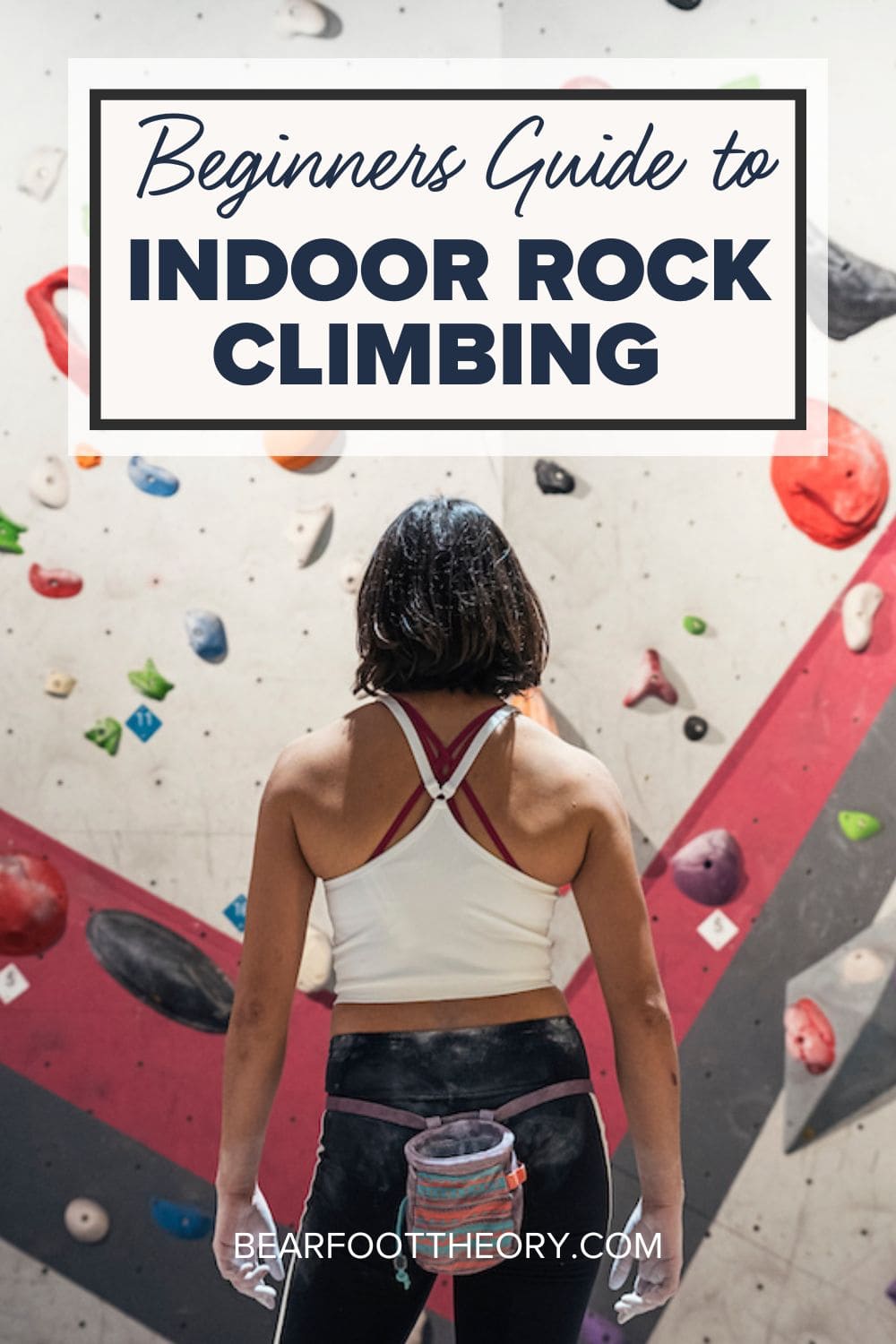A Beginner’s Guide to Indoor Rock Climbing
Learn what to expect on your first visit to an indoor climbing gym including what gear you need, climbing etiquette, and more!
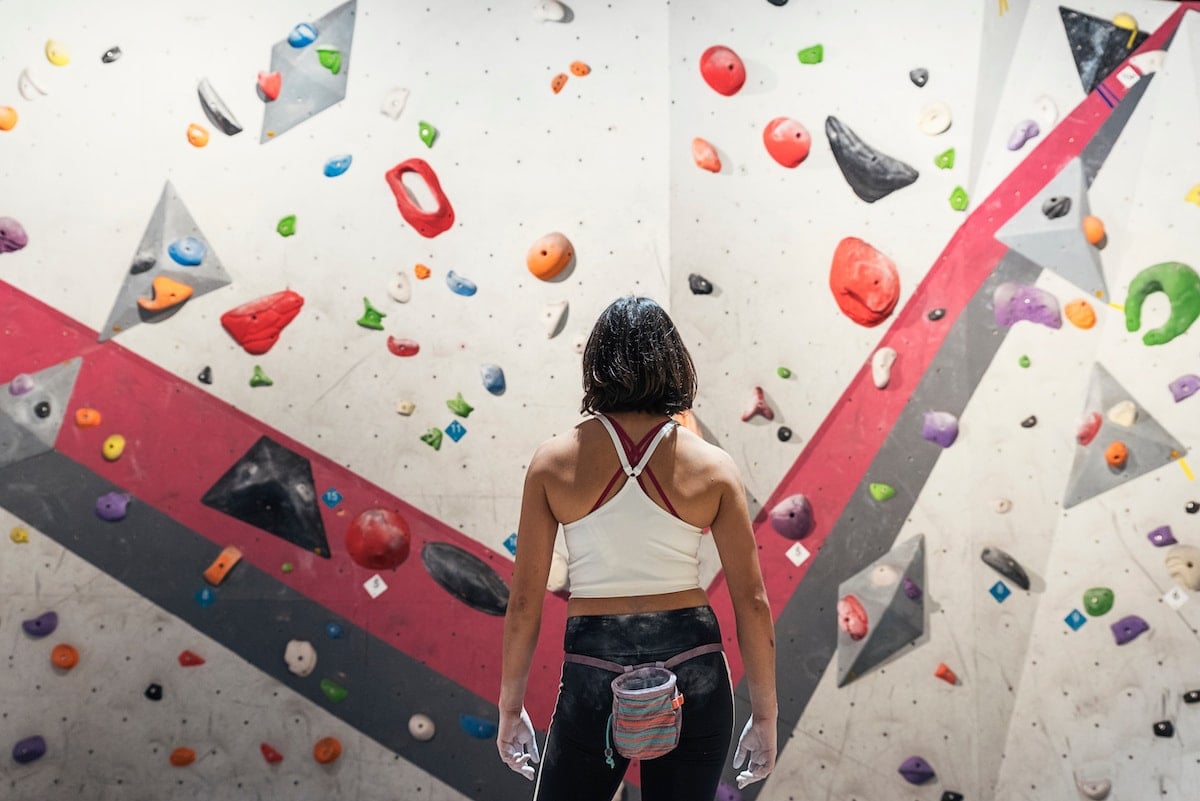
Rock climbing can seem pretty intimidating — it has a reputation for being dangerous and extreme. However, the sport is becoming increasingly popular and it’s not just for the risk-takers among us. If you’re thinking of Alex Honnold in the documentary Free Solo, risking it all with just a pair of shoes and a chalk bag on a belt around his waist, think again! There are plenty of ways to climb that prioritize your safety and fun.
The easiest and safest way to get started with climbing is by visiting your local indoor rock climbing gym. Gyms present an opportunity to build up your muscle, technique, and confidence before you head out to the “crag” (outdoor climbing spot). They also have safety measures in place that lower your risk while you’re learning. Climbing is a great activity to stay fit and make new friends, and below you’ll find all the climbing essentials for “gumbies” (climbing newbies)!
This post may contain affiliate links.
What Does Indoor Rock Climbing Look Like?
You may be wondering how indoor gyms compare to the majesty of El Cap or Half Dome. The answer is… they don’t. And they don’t exactly try to, either. Indoor climbing gyms look kind of like big playgrounds. There are plastic “holds” drilled into the walls and the objective is to climb up a route that someone has created, or “set.” The people who dream up these puzzles are called route-setters. They drill holds into the walls and take them down on a schedule, so the routes are always changing.
Climbing grades indicate the level of difficulty and will be posted somewhere in the gym. There are certain holds that you can use and cannot use based on the climb (“on” or “off”). You’ll also have to sign a waiver (pro tip: do this online, before you get there).
There are a few different types of indoor climbing, so make sure you talk to your local gym for info about what types of climbing they offer and ask what is available to new climbers.
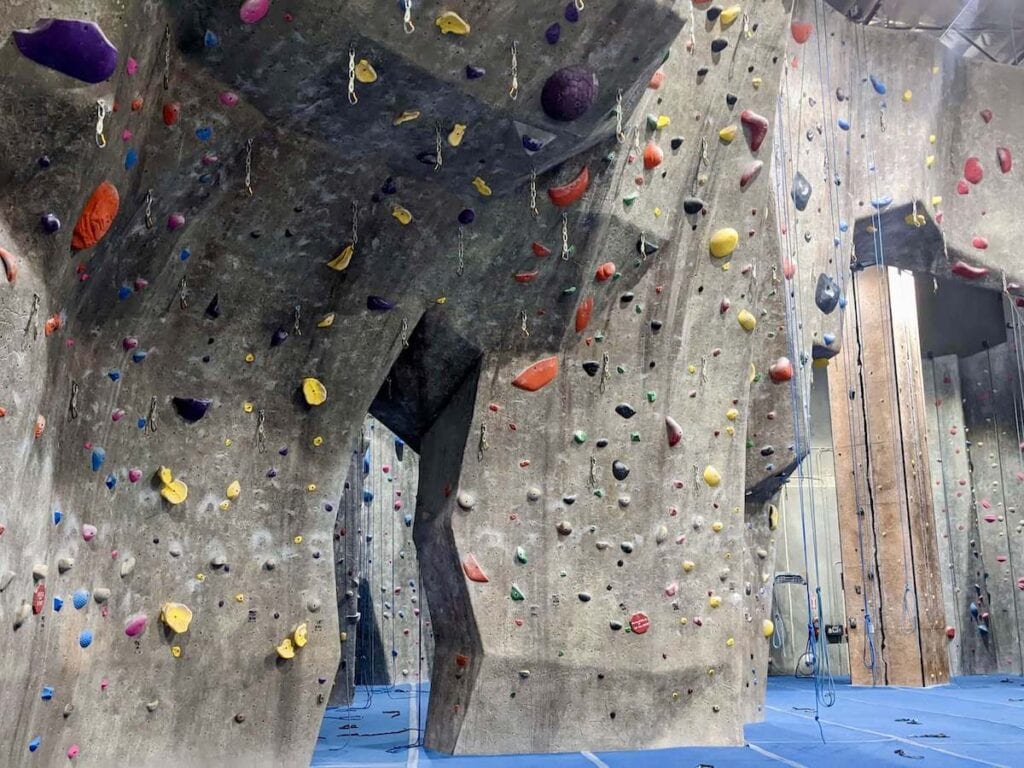
Save this post!
Enter your email & I'll send this post to your inbox! You'll also receive my weekly newsletter full of helpful advice for planning your adventures.
Types of Indoor Rock Climbing
Before you pack up and speed over to the gym, you should know that there are several different types of indoor rock climbing. Whether you’re excited by the prospect of scaling an awe-inspiring tall wall with ropes or you’re scared to fall, take a minute to figure out what style of climbing sounds fun to you:
Bouldering
Bouldering is a style of indoor climbing with shorter walls (~15ft) and no ropes. Don’t worry though—you’ll still have a giant mattress below you called a crash pad. Often, gyms will have most of their floor covered in big, foamy mats. These pads will cushion your fall (more on falling later). The objective of bouldering is to climb a preset route, or “problem”. You can think of a route as a short challenge or puzzle to solve. Many gyms differentiate routes based on color. That means in order to “complete” the climb, you have to use only the holds of a particular color (e.g. only purple holds).
Bouldering route difficulty is measured on the Hueco V Scale. The scale ranges from V0 to V17, where V0 is the easiest and V17 is the hardest. Most gyms will have a grade associated with a climb so you can get a feel for whether it’s in range for you. Even though boulder problems are short, they often require powerful moves and encourage learning good technique on the wall. Many gyms only offer bouldering. Since it requires the least amount of gear and is more widely available than other styles of indoor climbing, it’s a great place to start. Bouldering also tends to be more social than roped climbing because there you will take lots of breaks between routes.
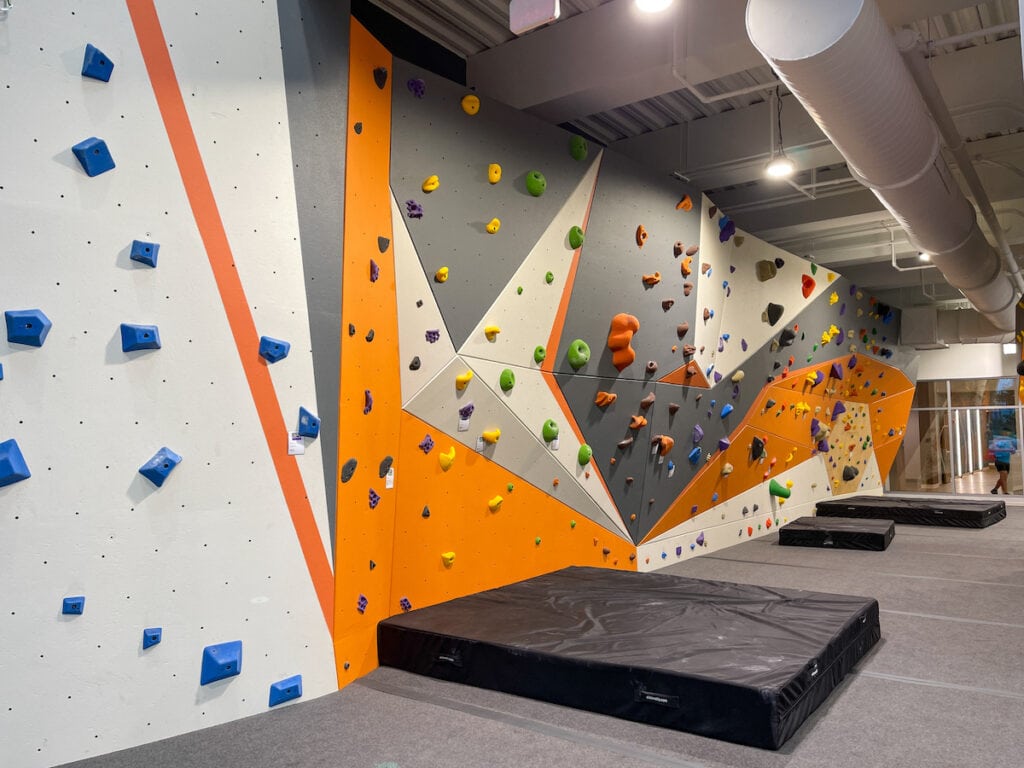
Top-roping
Top-roping is a style of climbing involving a roped climber and their partner, called a belayer. Top-rope climbs are significantly taller than boulders on average (anywhere from 20 to 60ft), but instead of falling onto a soft mat, you’re suspended in place by a rope. The rope will be tied to your harness with a special type of knot—called a figure 8—and will be connected to your belayer with a “belay device.” A top-rope will already be installed at the top of the wall.
You need a partner to top-rope and they will be responsible for catching you when you fall. Top-roping is considered one of the safest types of climbing because, done correctly, you should never fall more than a few inches. In order to top-rope, you must go with someone who already knows how to belay. You can sometimes pay for a class where a belayer will be provided to you for a set amount of time.
Additionally, gyms often offer classes so you can learn how to belay. Eventually, when you’re going regularly, you and your partner will likely want to switch off climbing, so it’s a great skill to learn. In the U.S., roped climbing is measured on a scale called the Yosemite Decimal System (YDS), where 5.0 is the easiest and 5.15 is the hardest (pay attention to the number after the decimal point).
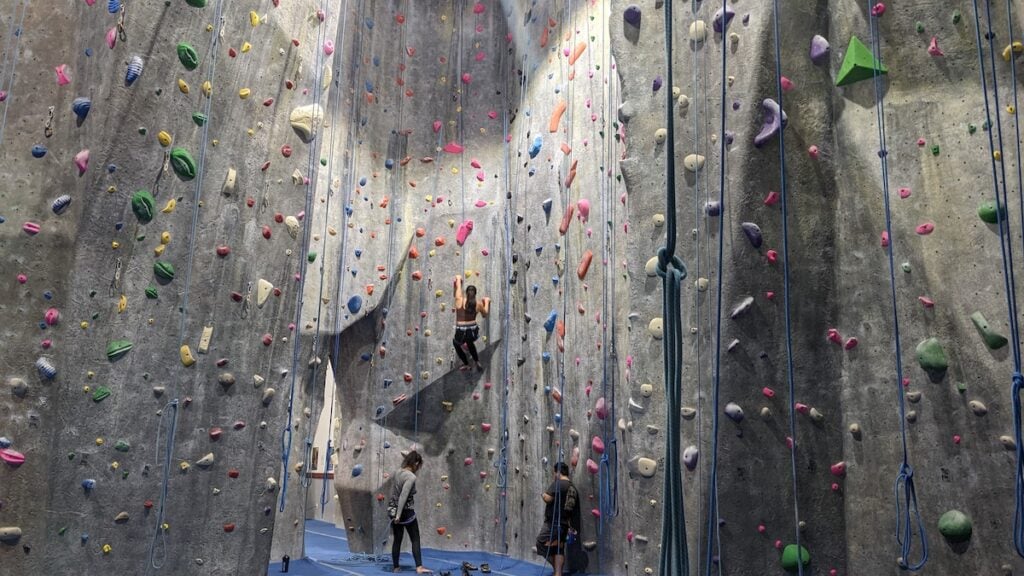
Auto-Belays
Climbing with an auto-belay is very similar to top-roping, except you won’t need a partner. You’ll walk up to the wall, clip a rope or “webbing” (a strong type of fabric) to your harness, and a device will automatically take in slack as you climb upwards. If you fall, the device will gently catch and lower you to the ground. You won’t find auto-belays in outdoor climbing.
Lead climbing
Lead climbing is an advanced type of climbing that also involves climbing with a rope. As with top-roping, you will have a harness, a knot tied to your harness, and a partner to belay you. Unlike top-roping, where the rope is already in place at the top of the climb, you will be taking the rope up with you.
As you climb up, you will clip the rope into “quickdraws,” which are carabiners attached to the climbing wall with a bolt. Because these bolts are spaced about every 3-5 feet, there is a high chance you will take a bigger fall—often up to 10ft. Done correctly, though, you should not “deck” (hit the ground) when lead climbing.
As with top-roping, your belayer is responsible for catching your falls. Lead climbing is a technical style of climbing that is not beginner-friendly.
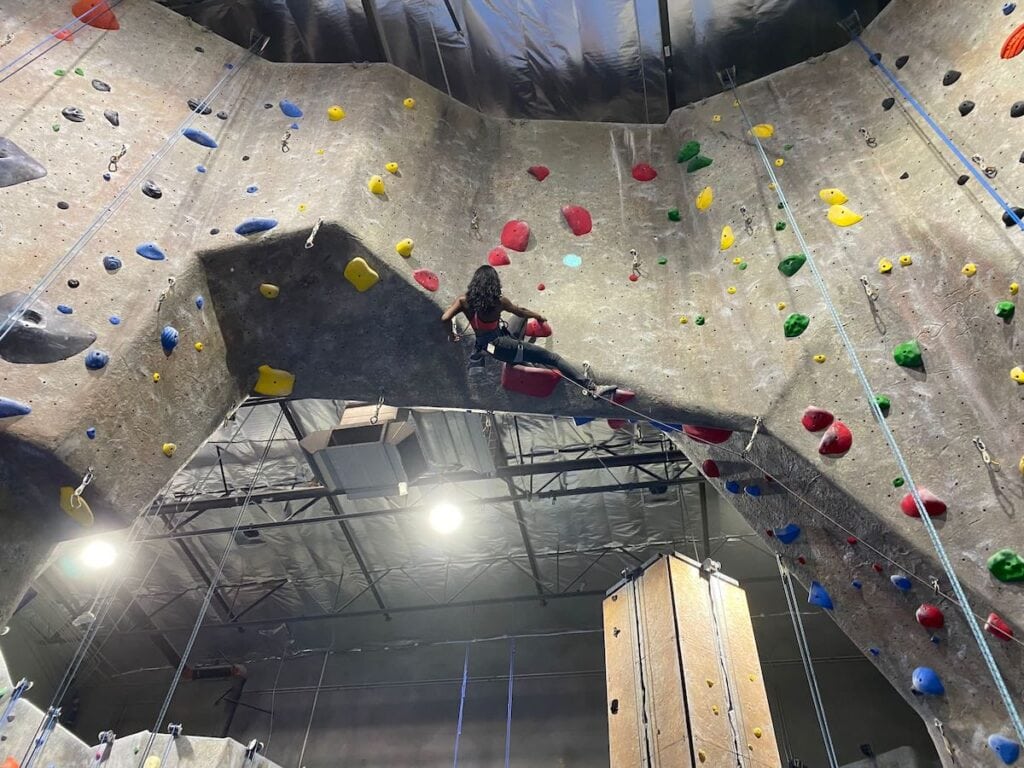
What To Wear Indoor Rock Climbing
You should wear clothes that are athletic and comfortable. For your very first time at a gym, a good choice would be a pair of comfy pants that don’t restrict your movement. Some people like spandex, while others prefer looser fabrics. Shorts are okay too but beware, you may bang your knees up. You can pair that with a t-shirt or tank top.
If you’re not going to rent shoes, wear close-toed shoes, ideally with rubber on the soles and toes. Your foamy sneakers aren’t going to “stick” to the wall as well and they might look a little worse for wear afterward too. Most climbers do not wear socks with their climbing shoes, but if you’re renting shoes, you might want to for hygiene reasons.
If you are heading to the climbing gym, trim your nails! Long nails can get snagged or break as you’re climbing. You should also cut your toenails if you plan to use climbing shoes because you can fit them more snugly without hurting your toes.
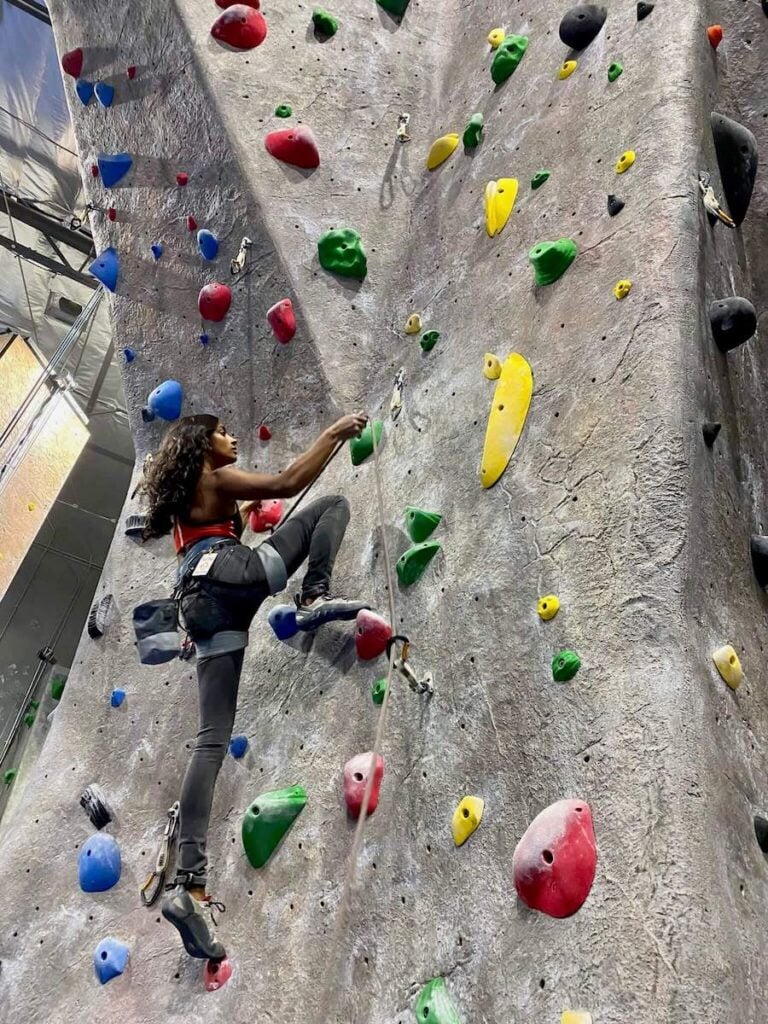
Indoor Rock Climbing Gear
Depending on the style of climbing you pick out of the list above, you will need different gear. If you’re just trying out climbing for the first time, you might want to rent some gear from the climbing gym. Typical indoor climbing gear includes a pair of climbing shoes, a harness (for rope climbing), and a chalk bag. Usually, gyms will have rental gear available. For rope climbing, you and your partner will need a belay device as well. You will not need a helmet for indoor climbing.
Ultimately, the amount of gear you actually need is up to you. If you’re going to boulder, you don’t strictly need any gear. If you’re going to rope climb, you’ll need a harness. If you have the option to rent something though, a pair of shoes is probably the most helpful for both disciplines. Climbing shoes are made with special rubber that helps you stand on even very small footholds.
Much like chalk for gymnasts, climbing chalk helps your clammy hands grip holds you might otherwise slip off. On your first day climbing, though, do not use chalk! Because chalk dries your hands out, they’ll be a lot more prone to superficial skin injuries like rawness and tears. Within a couple of weeks, your skin will toughen up and you’ll build calluses. At that point, chalk up all you want.
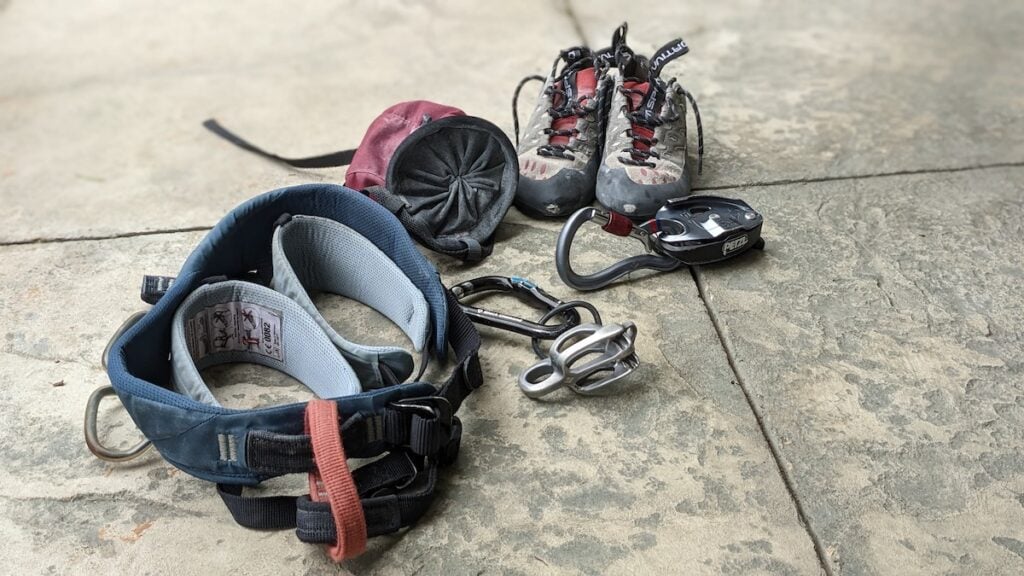
Once you’re confident you want to keep climbing, shoes, chalk, and a harness are great indoor rock climbing gear investments. Here are my top picks for indoor climbing gear:
- Shoes: La Sportiva Tarantulace or Scarpa Helix
- Harness: Black Diamond Momentum Harness (men’s)
- Chalk bag: Any chalk bag will do the trick, so express yourself!
You can also buy a value pack which includes a harness, belay device, and chalk bag (men’s harness package).

Tips for Indoor Rock Climbing
Now that we’ve gotten the basics down, here are a few of my best tips for having a strong day at the climbing gym:
Technique & footwork
Hauling yourself up a climb with your arm muscle alone is exhausting. As much as possible, look down for footholds and step on them to take the weight off your arms. Remember that your legs are stronger than your arms. If you’re stretching way upwards to find another handhold, try looking down for another foothold instead. A surprising amount of climbing depends on thoughtful footwork.
Keep “long arms”
Try not to bend your arm at the elbow when you climb. Bending your arm requires you to flex your muscles and that takes up a lot of extra energy. Keeping your arms “long” (extended) helps you avoid burning energy so you can keep climbing without getting tired.

Learn how to fall
In any style of climbing, you will fall and you will do so often. If you’re going to fall to the ground, which should only happen in bouldering, there are a few easy things you can do to keep yourself safe. Firstly, keep your arms tucked into your chest. Sticking your hand out to catch your fall might hurt your elbow. Secondly, once you hit the ground, let your knees buckle and roll onto your back as you fall. This will save your knees and back from absorbing the shock of the impact. This is relevant in particular to bouldering, where you will fall on a crash pad (a big mattress-like mat made of foam).
Stretching with prayer hands
Climbing works out your forearms, so you might start to experience “pump.” This is basically a throbbing in your forearms that means your body is like, “Woah, I don’t usually use those muscles!” If you start to feel pumped out (tired forearms), try putting your hands together like you’re praying. Then, keeping your hands together, bring them toward your waist. This will stretch out your forearms after a long, hard day climbing.
Spotting
Like in weightlifting, you can spot other people if they’re trying something hard. You only need to spot if your climber will fall to the ground, as in bouldering and before the first clip in lead climbing. This can make a climber feel safer and help them fall better. The goal of spotting is not to catch a falling climber, but to help guide their body to a safe landing.
To spot, hold your hands up with thumbs tucked (think of holding up the number “4”). You should also keep your fingers close together to avoid injury. When your climber falls, you can help guide their midsection (their center of gravity) toward a soft landing, paying special attention to their head.
Indoor Rock Climbing Etiquette
Don’t get me wrong, climbers love an element of lawlessness, but there are a few rules you should keep in mind when climbing:
- Don’t climb/walk in the fall zone. Climbing/walking under other climbers on the wall is unsafe for both of you. Climbing gyms utilize vertical space, so look up! No one wants to fall on you.
- Don’t climb right next to someone. Similar to the above, this is unsafe. You could end up falling on each other, or falling at the same time. It also crowds other climbers.
- Check to make sure your route doesn’t intersect with someone else’s route. Often, routes at the gym intersect. If this is the case, make sure no one else is already on a route that would overlap with yours. The person already on the wall takes precedence.
- Watch your kids. If you brought little climbers, help them be safe by spotting them if they’re bouldering and actively making sure they’re not running under other climbers.
- Don’t hog a route. Lots of routes intersect and lots of people want to try different climbs. Let other people have a chance to climb, too. After one or two attempts, step aside and see if anyone else is waiting on you.
- Don’t step on ropes. Ropes are lifelines and climbers care about keeping them clean. If you can avoid it, try not to step on the ropes.
- Be kind. Climbing can be scary for people who are new. It can also be physically challenging. Being encouraging and thoughtful goes a long way in life and in the gym!
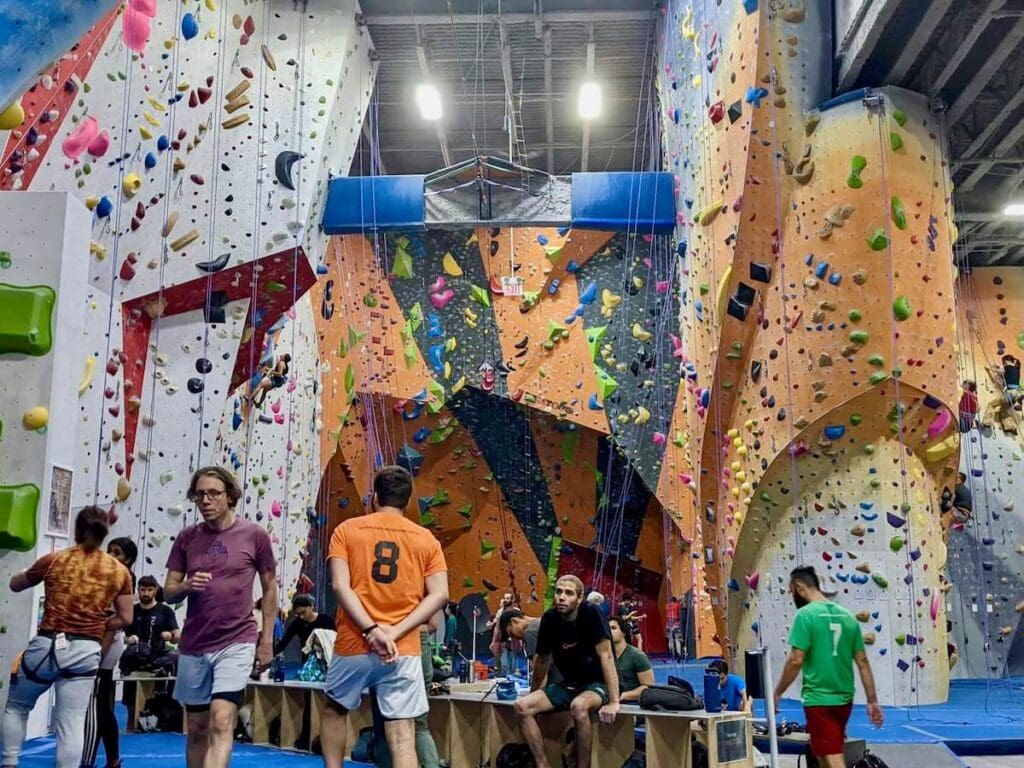
Beginner Indoor Rocking Climbing FAQ
Who Should Indoor Rock Climb?
A climber should be in touch with their mind and body because climbing presents a mental challenge as well as a physical one. You can climb if you’re short, tall, young, old, skinny, or a little on the heavier side. My mom just started climbing at 61! Professional climber Lynn Hill, at 5’2, is one of the most successful climbers ever. If you have a sense of adventure and a desire to start climbing, giving it a whirl is well worth it.
Some of the physical demands of climbing include good balance, flexibility, and leg power. You may be surprised to find that some muscular people struggle to climb. In climbing, strength isn’t everything.
Bringing a friend is a nice way to take the pressure off and spend some quality time with another person. Go ahead and chat with some of the experienced climbers at the gym—they’re often excited to see new climbers and it’s a chance to make some new friends. Plus, they might give you some “beta” (tips on how to climb a route). Climbing gyms are social places!
How Much Does Indoor Rock Climbing Cost?
You can usually buy a climbing day pass for $20-$35. Gear rental costs on average $5-10, but sometimes it’s included in the price of your day pass—call ahead to your local indoor climbing gym to inquire.
If you’re thinking, “I can’t afford to do that a few times every week!”, fret not. Climbing gyms also offer memberships just like regular gyms which makes everything a lot more affordable.
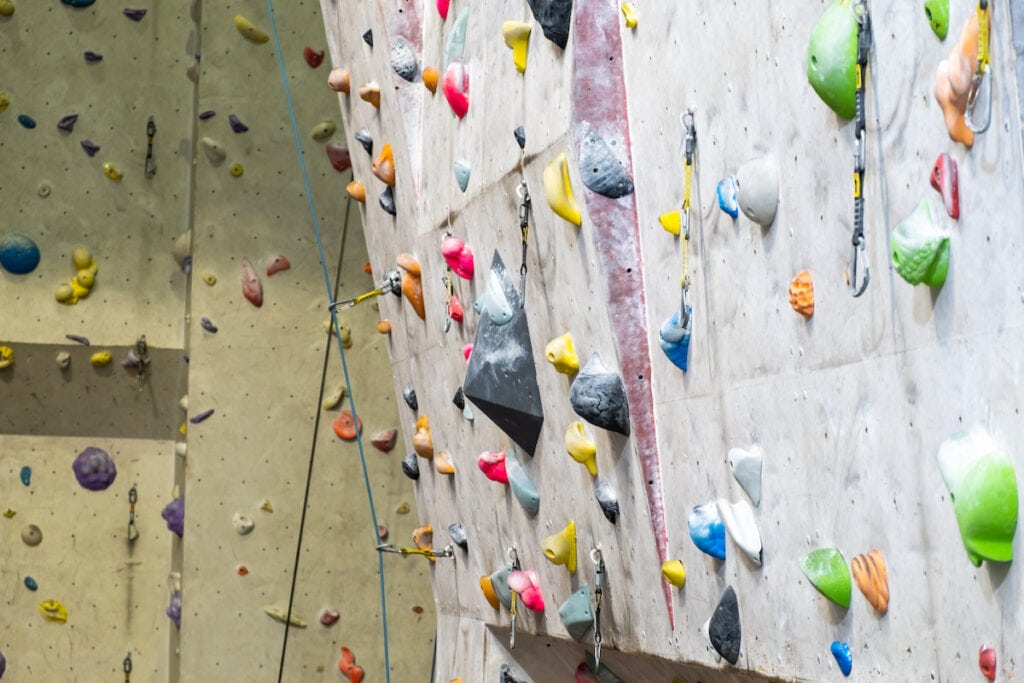
Is Indoor Rock Climbing Dangerous?
Climbing, like most activities, carries risk. It certainly deserves respect as a potentially dangerous activity. Whether it’s too dangerous is for you to decide. Climbing, at its core, is about knowing yourself, trusting yourself, and pushing your limits.
That said, indoor climbing gyms are surprisingly safe places and very few serious injuries occur. People can and do get hurt, though. Boulderers often sprain ankles from falling on crash pads poorly, and it’s possible to pull a muscle or sprain a wrist. All that said, climbing gyms are motivated to keep you safe for insurance purposes. They will update their gear, inspect their equipment, and test you for competency in roped climbing. This is called a belay test. It’s a lot harder to injure yourself at an indoor climbing gym for these reasons. Climbing is therefore a lot safer than you might expect!
Additionally, falling is not an unusual part of climbing—it’s very common. In fact, much of climbing involves falling, and there are many safety measures in place to ensure that you fall safely, whether it’s onto a big crash pad or on a rope.

Is Indoor Rock Climbing Scary?
If you’re scared of heights or scared of falling, you’re not alone. That’s a totally normal human instinct and is a really helpful way to keep yourself alive! You can still climb, even if you’re scared.
If you’re very scared of falling, you may like top-rope climbing because you will not fall more than a few inches.
If you’re scared of heights, you may prefer bouldering because you won’t climb higher than about 15ft.
If you’re wondering if you’re too scared to climb, I would encourage you to give it a try. Comfort with heights and falling takes time to build up and still afflicts even the very best climbers.
Are Kids Allowed At The Climbing Gym?
Bringing kids to indoor rock climbing gyms is a great way to get their extra energy out, and kids are often freakishly good climbers. That said, most kids aren’t totally stoked about climbing until they’re about 5, even if they climb all over your furniture at home.
If you are planning to bring your child, make sure that you check with your local gym to see if they are old enough to climb. Also, note that climbing gyms are very much not playgrounds. Do not let your little one run amok through the gym. There is a very real risk that someone will fall on them. They will need your full attention and supervision. Some gyms offer classes for kids (youth programming), which might be an option to explore if you want your child to burn a little extra energy without you.

How to Transition from Indoor Rock Climbing to Outdoor Climbing
Climbing outside is pretty different from climbing in a gym. There are different skills you’ll need to learn, and you’ll be (more) responsible for your own safety. As you become a more experienced indoor climber, your skills will grow and you’ll have a lot more options outdoors. Climbing outside tends to be quite a bit harder than it is inside, so it’s worth spending a little time getting fit for the outdoors.
When you’re ready to climb outside, I strongly recommend going with someone you trust. Beyond that, go with someone whose opinions on safety you trust. Climbing is only as safe as the people you’re climbing with. Always tell someone else where you are and what your plans are. If you don’t know anyone who climbs outside or if you feel more comfortable with a pro, you can hire a professional guide or take a class through REI.
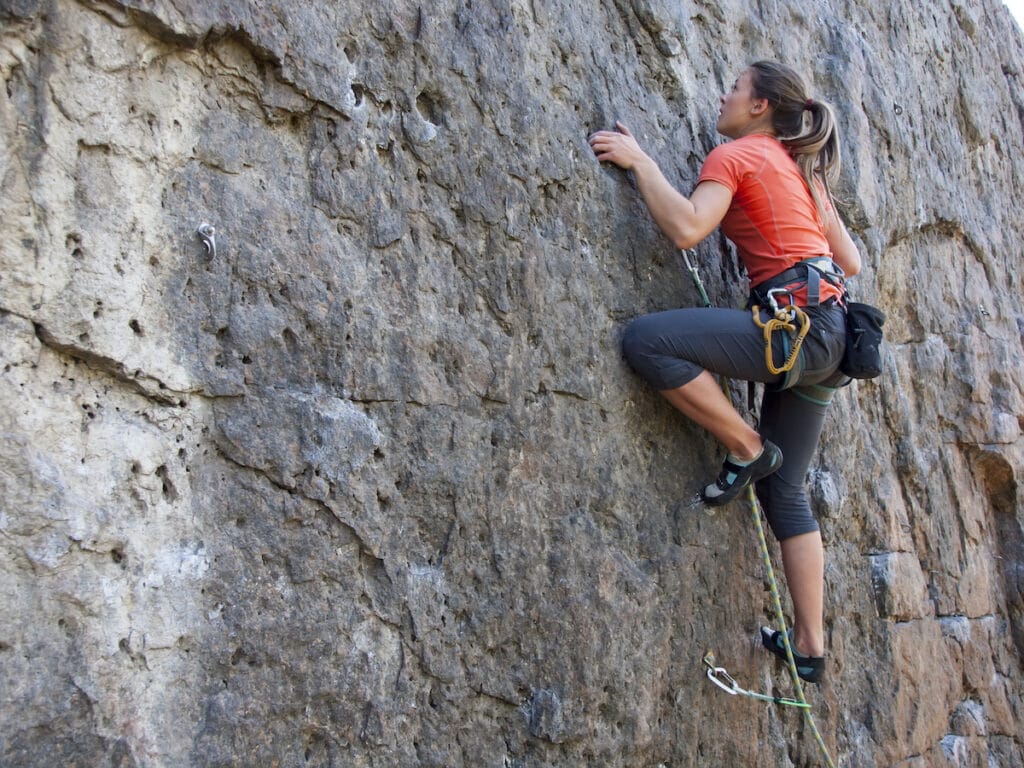
READ NEXT
Interested in our other Outdoor 101 guides? Check out these blog posts:
Have you tried indoor rock climbing? What was your first experience like? Leave a comment below!

